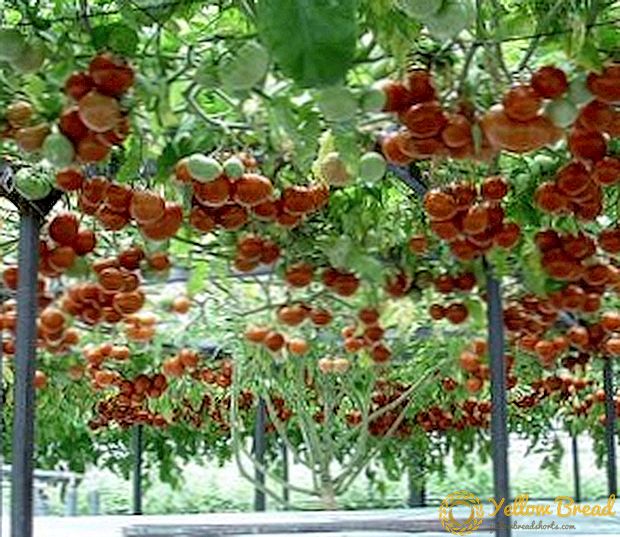 Most experienced gardeners are familiar with the variety of tomato "Cardinal". The variety is unpretentious in care and gives a relatively good harvest. Today we will talk about planting seedlings and pickings in open ground, as well as discuss the rules of care and protection from diseases and pests.
Most experienced gardeners are familiar with the variety of tomato "Cardinal". The variety is unpretentious in care and gives a relatively good harvest. Today we will talk about planting seedlings and pickings in open ground, as well as discuss the rules of care and protection from diseases and pests.
- Characteristics and description of the variety
- Pros and cons varieties
- Growing tomatoes "Cardinal" through seedlings
- When to sow on seedlings
- Soil and capacity for growing seedlings
- Seed preparation for sowing
- Sowing seeds for seedlings
- Conditions and care for crops
- Care for tomato seedlings
- Location and lighting
- Watering
- Top dressing
- Hardening
- Transplanting seedlings of tomatoes in a permanent place
- Optimum time for disembarkation
- Selecting a landing site: lighting and soil
- Planting plantation seedlings
- The role of predecessors
- Tips on caring for tomatoes "Cardinal"
- Watering and feeding tomatoes
- Weeding and loosening the soil
- The role of mulch
- Garter to support
- Pruning and shaping bushes
- Prevention and protection against pests and diseases
Characteristics and description of the variety
Now let's talk a little more about the Cardinal tomato, namely, the description and characteristics of the variety.

The variety is self pollinated.The stem is creeping and requires a garter to the trellis. In greenhouse conditions, the bush grows up to 2 m in height, and in the open area - up to 1.6 m.
Tomato "Cardinal" has a bright pink skin color and strong aroma. The skin is dense, and the pulp is juicy, without veins. The weight of one tomato reaches 900 g in the period of the first fruiting. In subsequent harvests, the fruits become shallow..
The first fruits you will receive in July. Tomato "Cardinal" is great for salads, pickling and canning. They make mashed potatoes and sauces from ripe tomatoes. Tomatoes perfectly tolerate transportation and do not lose their properties and presentation during long-term storage.
Pros and cons varieties
Tomatoes "Cardinal" have many advantages:
- fruits are tasty and juicy;
- the variety is disease resistant;
- quick seed germination;
- high frost resistance;
- used in any form.
- a bush needs shaping;
- a garter is required.
Growing tomatoes "Cardinal" through seedlings
In the greenhouse, the Cardinal tomatoes give more yield, so we decided to tell you about growing seedlings for subsequent picking in the greenhouse.
When to sow on seedlings
Tomato seeds "Cardinal" should be sown in the first decade of March.The variety is frost resistant and well survive the low temperature.
Soil and capacity for growing seedlings
The variety is best planted in nourishing light ground. Earthen mixture - garden and sod land with old humus. You can also add wood ash and superphosphate. This adds nutritional value to the soil.
You can also take the soil from the beds after legumes, as well as cabbage, cucumbers and onions.
Containers are suitable as a growing container (depth - 2 cm). You can also use peat pots with a volume of 200 ml. This will allow you to plant seedlings in the ground in peat pots, so as not to injure the root system.
Seed preparation for sowing
In order for the seedlings to ascend faster, you can use special preparations (growth stimulants). Seeds need to soak for 12 hours.
But first, it is recommended to decontaminate the seeds by soaking them in a pink solution of potassium permanganate for 30 minutes, then rinse under running water.
Sowing seeds for seedlings
Seeds are sown in one container for several seeds. Then the soil must be moistened with warm water and cover the boxes with plastic wrap. The container should be moved to a room with a temperature of 26 ° C.
Conditions and care for crops
We discussed the characteristics of tomatoes, sowed, and now we should provide care for the seedlings after planting. As soon as the first shoots appeared, the boxes should be moved to a sunny place. After the first leaves, the tomatoes should be moved to separate pots, watered and fertilized with mineral fertilizers.
Care for tomato seedlings
Tomatoes "Cardinal" after planting is required and care already for the shoots. In the following sections, you will learn how to care for seedlings of crops and get a big harvest.
Location and lighting
Since the Cardinal tomatoes love heat and light, they need to ensure the right conditions. You need to install additional lighting to ensure good illumination.
The temperature for the growth of seedlings is not below 25 ° C. That is, it is better to put the boxes with seedlings under diffused sunlight.
Watering
After planting, the seeds should not be watered. It will be enough to spray from the spray.

Watering is best done in the morning or in the evening. You can also mulch the soil at the roots. This will reduce the amount of watering and provide air access to the root system.
Top dressing
Fertilizers are an important treatment, on which depends how large and healthy the fruits will be. Complex fertilizing fertilize the plant at the seedling stage. This helps the seedlings to quickly grow green mass and roots.
Hardening
This stage will help to acclimatize the seedlings before transplanting seedlings to a new place. To do this, you need to make seedlings for a while in a cool room, but only in warm weather. Plants need to be protected from the sun and drafts.
Transplanting seedlings of tomatoes in a permanent place
Planting and cultivation of seedlings of tomatoes "Cardinal" is completed. In the following sections, you will learn exactly how to transplant seedlings to open ground.
Optimum time for disembarkation
Planting of seedlings in open ground is carried out around the beginning of June.
Selecting a landing site: lighting and soil
For growing seedlings of tomatoes, choose a place with diffuse lighting.The soil should be fertilized with peat-humus earthen mixture. You can also replace the mixture of soil with humus.
Planting plantation seedlings
Seedlings should be planted according to the scheme 70 x 80 cm apart. Then seedlings watered with warm water. After this, the greenhouse must be covered with a film and fastened at the edges in order to create a greenhouse effect.
The role of predecessors
Tomatoes "Cardinal" require certain nutrients that are contained in the soil. So, this variety can be planted in places where cucumbers, summer squash, zucchini, pumpkins, cabbage, onions, garlic, and radishes previously grew.
The bad forerunners will be peppers, potatoes, eggplants, and any other members of the nightshade family.
Tips on caring for tomatoes "Cardinal"
When tomato seedlings "Cardinal" was in a permanent place, do not neglect the care of vegetables, because the yield depends on it.
Watering and feeding tomatoes
Adult tomatoes should be watered sparingly, using exceptionally warm and soft water.
During the season you also need to fertilize the bushes four times with full complex fertilizers.
Weeding and loosening the soil
The next important step to healthy plants is ground treatment. The ground under the tomatoes should be loose. Loosening every 14 days after watering. This improves the temperature and humidity conditions of the soil.

Loosening should be combined with hilling in the period of growth of bushes. This will not allow the root system to become bare and will create optimal conditions for heating the soil and sprouting the roots. It will also accelerate the ripening of vegetables.
The first hilling should be carried out in 14-21 days after planting, and the next - in 2 weeks. This treatment is made wet ground.
The role of mulch
Mulching will save you from the following concerns:
- regular loosening and weeding from weeds;
- protection of roots from frost;
- prevention against bacteria and disease.
Straw is suitable for mulching tomatoes - this is a great organic material. However, it can attract unwanted insects and rodents, from which only a chemical can help you.Straw unfolds in the landing zone and is removed only upon the arrival of warm weather.

Garter to support
Garter to the support is very important when growing tomatoes. This design can be made from scraps of seedlings, vegetable and woody lianas, twine, wood rod and poles.
For example, you can make the following support for a tomato: we take three hoops of different diameters and fix them on three sticks. Hoops have bottom-up - from smaller to larger diameter.
Pruning and shaping bushes
The important step is the stew of tomatoes. You need to cut only the lower leaves and lateral processes. Leave two stalks should be. For tall plants, pinch the growing point.
Prevention and protection against pests and diseases
Like all crops, tomatoes are also attacked by various parasites and diseases.
For prevention, it is desirable to ventilate the greenhouse and destroy weeds. You can also be helped by mulching with peat or humus.

Young plants are sprayed with a pale pink solution of potassium permanganate or Fitosporin for various diseases.
Of the pests, tomatoes can infect naked slugs, aphids, whitefly and thrips. To prevent the attack of these parasites, it is advisable to heat the soil in the oven before planting the seedlings in boxes. This will destroy the larvae in the ground.
Be sure to look at the leaves from the bottom, and if you notice any webs or sticky streaks, wash them off with a damp cloth and then spray the plant with a weak solution of potassium permanganate.
From slugs you will help frequent spraying with warm water with ammonia.
Aphids will disappear if the parasites are washed away with warm soapy water.
From spider mites will help insecticides. Processing is carried out three times with breaks of several days.
The variety of tomatoes "Cardinal" is great for growing in greenhouses. With our recommendations, you can grow sweet and juicy tomatoes effortlessly.






